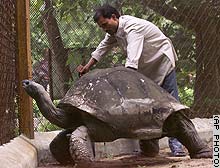Researchers zero in on a cause of aging
Experiment points to defect in cells
By Alice Dembner, Globe Staff | May 27, 2004
Taking a major step toward identifying one cause of aging, researchers have shortened the life of mice and created signs of old age by injecting a
small genetic defect in the mice's mitochondria, the tiny power plants within each cell.
The experiment in Sweden offers the first hard evidence of a decades-old theory that mutations in the mitochondria are one of the causes of
age-related illnesses. Earlier research had shown that such defects build up in people as they grow old, but scientists were not sure whether that was
a cause or a symptom of aging.
''What we have now is this clear-cut cause-and-effect relationship," said Dr. Nils-Goran Larsson, a genetics professor at the
Karolinska Institute in Stockholm and the senior author of the study. ''It will provide a completely new angle to treat aging-related
problems."
Other researchers, however, said the theory won't be fully proven until experiments extend the life span of mice by eliminating defects in the
mitochondria.
Larsson said the new results could lead to the development of drugs or procedures to ward off the changes to the mitochondria. A number of companies
are already working on other compounds, potentially related to mitochondria, to tackle the diseases of old age.
The study, published in today's issue of the journal Nature, comes as researchers are unlocking many of the mysteries of aging. Scientists have
identified a number of genes that affect aging in animals. They have linked the natural shortening of telomeres, the tail ends of chromosomes, to
shorter life spans. In addition, researchers have added years to the lives of mice by increasing their ability to disarm byproducts of metabolism
called free radicals, which can damage cells.
Since mitochondria also generate free radicals, the latest work may also propel work on the free-radical theory, researchers said.
A separate path of research is focusing on factors that regulate life span, rather than on the causes of aging. Altering the genes that control
insulin receptors can double the life span of worms, researchers have shown.
David Sinclair, a molecular geneticist at Harvard Medical School who works on the regulators of aging, said the Swedish experiment
''suggests -- but doesn't prove -- that mitochondria might really play an integral part in the aging process" and he suggests that
the regulators will prove more important in combating aging than the causes. ''We believe that manipulating the regulators of aging will
have a much larger effect on longevity because these regulators could potentially slow down all the causes of aging, not just one," Sinclair
said.
However, Dr. George M. Martin, a geneticist at the University of Washington in Seattle who wrote an article accompanying the Swedish study, said the
paper makes ''an important contribution because . . . changes in the mitochondrial DNA may be among the more important processes of
aging."
Mitochondria are the structures in each cell of the body that convert fat and sugar into usable energy. If they severely malfunction, humans
eventually die. The theory that damage to the mitochondria caused aging was first proposed in 1972, according to Sinclair. Evidence piled up that
these changes were common in older people and animals, but no one had attempted to prove the connection.
In the Swedish experiment, researchers genetically engineered the mice to have a defect in their mitochondria. They replaced a single amino acid,
which disabled the ability of the mice to find and correct errors in their mitochondrial DNA. As the mitochondria replicated themselves as part of
normal growth and development, errors built up.
Starting at young adulthood (24 weeks), the mice began to show symptoms of premature aging, including weight loss, hair loss, curvature of the spine,
osteoporosis, and enlargement of the heart. They lived an average of 48 weeks, and all had died by the age of 61 weeks. Normal lab mice can live up to
two years. Designing the experiment and carrying it out took a painstaking four years, Larsson said. ''I now know why no one had done it
[before]," he said.
Larsson said next steps would include researching the underlying mechanisms and figuring out how they relate to other possible causes of aging. In
addition, he said, the mice would be used to design ways to counteract the problem using drugs, diet, or genetic alterations.
|



 or just plain old
entropy.
or just plain old
entropy. 


